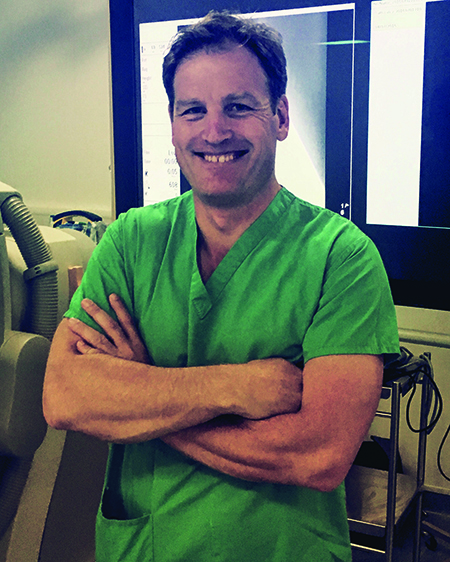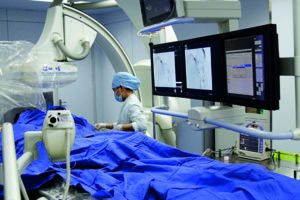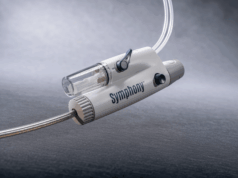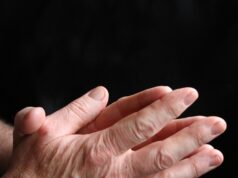
Research presented at the European Society for Vascular Surgery’s annual meeting (ESVS; 25–28 September, Valencia, Spain) has shone a light on the potentially high cumulative radiation exposure associated with certain venous procedures. Addressing the issue, Stephen Black (Guy’s and St Thomas’ Hospital, London, UK) called for further studies to identify strategies that can reduce radiation exposure, and highlighted the need for increased awareness among interventionalists.
Black indicated that there has been an increase in treatment options for deep vein thrombosis (DVT) in particular and for chronic venous patients over the last few years. While the advances are exciting, it is easy to forget that they come with potentially harmful side effects. Black compared modern venous procedures with endovascular aneurysm repair (EVAR), drawing particular attention to the young age at which venous patients typically require treatment, corresponding with a much longer lifetime of follow-up and potential reintervention procedures.
“It is important to highlight the potential for harm in this patient group who are an average age of 30–40 years, as opposed to the older patients who typically undergo EVAR, for example. The EVAR 1 trial reported an increased incidence of malignancy in patients treated endovascularly after 15 years follow-up. Patients who need thrombolysis or inferior vena cava (IVC) reconstruction are often younger than those with arterial problems and may also require long-term surveillance and secondary interventions, exposing them to further radiation,” Black pointed out.
To investigate the radiation exposure associated with venous procedures, Black and colleagues conducted a retrospective cohort study of patients with symptomatic ilio-femoral deep vein thrombosis and chronic IVC reconstruction, followed for a minimum of one year in order to capture reintervention data. Estimated radiation exposure from the related preoperative, index and postoperative interventions were measured in dose-area product and fluoroscopy time.
At St Thomas’s Hospital, Black explained that all procedures are performed in either the hybrid vascular theatre or in the angiosuites. Default background settings are used with a fluoroscopy pulse rate of 7.5/second in the hybrid operating theatre, 3.0/second in the angiosuite and two frames per second for digital subtraction angiography acquisitions for all rooms.
The 39 patients enrolled in the study were a median age of 35 years (range=18–73) and 27 were male. Nineteen patients were treated for lower extremity DVT and 20 for upper extremity DVT, and these two groups were looked at separately to observe any differences.
 In terms of the configuration of stents for IVC reconstruction and the level of disease, three patients had unilateral iliac stents into the IVC, but the dominant group were either to the suprarenal component or a stent extension to the hepatic confluence.
In terms of the configuration of stents for IVC reconstruction and the level of disease, three patients had unilateral iliac stents into the IVC, but the dominant group were either to the suprarenal component or a stent extension to the hepatic confluence.
The cumulative radiation exposure to patients undergoing IVC reconstruction was predictably higher, Black reported, with a mean dose-area product of 81,131Gy-cm2. Additionally, fluoroscopy time was long, with some procedures taking up to six hours. Level of radiation exposure also depended on the region which was stented.
“If we look at the difference between the two, it is clear that the stents that extended into the hepatic segment were associated with significantly more radiation exposure than those that remained below the infrarenal component. The cumulative radiation exposure, if we include all the follow-up, remains relatively similar in both the acute and chronic IVC stent extension patients. Further, we found that in patients with upper extremity DVT, the procedure was far quicker and therefore associated with far less radiation than lower extremity DVT. The same applies for cumulative dose-area product and fluoroscopy time for all the reinterventions that occurred in the year after the initial procedure and the surveillance,” Black reported.
Comparing radiation dose measurements for IVC reconstruction with other vascular procedures, Black noted that it is significantly higher than lysis, for example, which has a median radiation exposure of 9Gy-cm2 and 981 seconds of fluoroscopy time compared with 60.8Gy-cm2 and 2,846 seconds for IVC. Compared to procedures such as EVAR and thoracic EVAR (TEVAR), however, the venous treatments do remain lower—especially complex procedures which have been associated with 287Gy-cm2 dose-area product and 4,152 seconds fluoroscopy time—but Black maintained that there should still be concern for the amount of radiation venous intervention patients are exposed to.
“This does not really change the story for venous patients. We can see that IVC reconstruction does have a high dose of radiation exposure, with cumulative radiation over 40–50 years of a patient’s life really needing to be taken into account. The initial procedure for acute DVT is relatively low, but it is not insignificant, and these patients really are much younger than the arterial population and we need to be much more aggressive in reducing their exposure early on,” Black stated.
At his hospital, he said that they have moved to using magnetic resonance (MR) venogram instead of computed tomography (CT) scan in all of these patients for their initial work-ups, so as not to expose them to additional radiation dose. In particular, he added, the use of intravascular ultrasound (IVUS), helps to reduce radiation exposure in the form of contrast-enhanced runs, and is one of the main strategies he uses to reduce dose.
“As interventionalists, we have to learn that often we use another run as time to think about how to proceed, and we have to start getting out of these habits that expose not only ourselves but the patients to more radiation,” Black said.
He concluded, adding that more needs to be done to raise awareness about the importance of reducing radiation dose wherever possible, and maintained that more strategies, such as the use of IVUS, need to be identified and put into practice.








